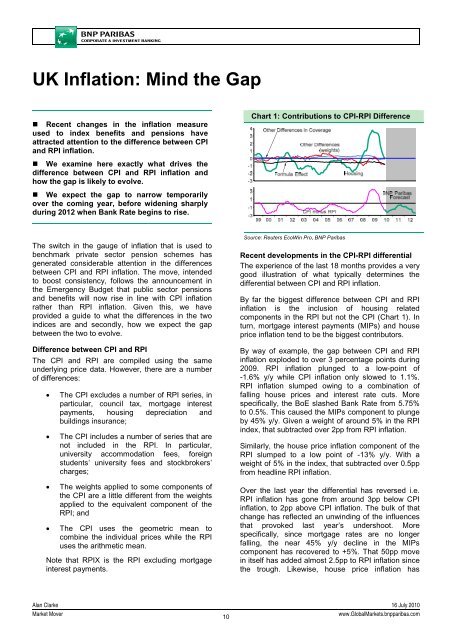Market Economics | Interest Rate Strategy - BNP PARIBAS ...
Market Economics | Interest Rate Strategy - BNP PARIBAS ...
Market Economics | Interest Rate Strategy - BNP PARIBAS ...
You also want an ePaper? Increase the reach of your titles
YUMPU automatically turns print PDFs into web optimized ePapers that Google loves.
UK Inflation: Mind the Gap<br />
• Recent changes in the inflation measure<br />
used to index benefits and pensions have<br />
attracted attention to the difference between CPI<br />
and RPI inflation.<br />
Chart 1: Contributions to CPI-RPI Difference<br />
• We examine here exactly what drives the<br />
difference between CPI and RPI inflation and<br />
how the gap is likely to evolve.<br />
• We expect the gap to narrow temporarily<br />
over the coming year, before widening sharply<br />
during 2012 when Bank <strong>Rate</strong> begins to rise.<br />
The switch in the gauge of inflation that is used to<br />
benchmark private sector pension schemes has<br />
generated considerable attention in the differences<br />
between CPI and RPI inflation. The move, intended<br />
to boost consistency, follows the announcement in<br />
the Emergency Budget that public sector pensions<br />
and benefits will now rise in line with CPI inflation<br />
rather than RPI inflation. Given this, we have<br />
provided a guide to what the differences in the two<br />
indices are and secondly, how we expect the gap<br />
between the two to evolve.<br />
Difference between CPI and RPI<br />
The CPI and RPI are compiled using the same<br />
underlying price data. However, there are a number<br />
of differences:<br />
• The CPI excludes a number of RPI series, in<br />
particular, council tax, mortgage interest<br />
payments, housing depreciation and<br />
buildings insurance;<br />
• The CPI includes a number of series that are<br />
not included in the RPI. In particular,<br />
university accommodation fees, foreign<br />
students’ university fees and stockbrokers’<br />
charges;<br />
• The weights applied to some components of<br />
the CPI are a little different from the weights<br />
applied to the equivalent component of the<br />
RPI; and<br />
• The CPI uses the geometric mean to<br />
combine the individual prices while the RPI<br />
uses the arithmetic mean.<br />
Note that RPIX is the RPI excluding mortgage<br />
interest payments.<br />
Source: Reuters EcoWin Pro, <strong>BNP</strong> Paribas<br />
Recent developments in the CPI-RPI differential<br />
The experience of the last 18 months provides a very<br />
good illustration of what typically determines the<br />
differential between CPI and RPI inflation.<br />
By far the biggest difference between CPI and RPI<br />
inflation is the inclusion of housing related<br />
components in the RPI but not the CPI (Chart 1). In<br />
turn, mortgage interest payments (MIPs) and house<br />
price inflation tend to be the biggest contributors.<br />
By way of example, the gap between CPI and RPI<br />
inflation exploded to over 3 percentage points during<br />
2009. RPI inflation plunged to a low-point of<br />
-1.6% y/y while CPI inflation only slowed to 1.1%.<br />
RPI inflation slumped owing to a combination of<br />
falling house prices and interest rate cuts. More<br />
specifically, the BoE slashed Bank <strong>Rate</strong> from 5.75%<br />
to 0.5%. This caused the MIPs component to plunge<br />
by 45% y/y. Given a weight of around 5% in the RPI<br />
index, that subtracted over 2pp from RPI inflation.<br />
Similarly, the house price inflation component of the<br />
RPI slumped to a low point of -13% y/y. With a<br />
weight of 5% in the index, that subtracted over 0.5pp<br />
from headline RPI inflation.<br />
Over the last year the differential has reversed i.e.<br />
RPI inflation has gone from around 3pp below CPI<br />
inflation, to 2pp above CPI inflation. The bulk of that<br />
change has reflected an unwinding of the influences<br />
that provoked last year’s undershoot. More<br />
specifically, since mortgage rates are no longer<br />
falling, the near 45% y/y decline in the MIPs<br />
component has recovered to +5%. That 50pp move<br />
in itself has added almost 2.5pp to RPI inflation since<br />
the trough. Likewise, house price inflation has<br />
Alan Clarke 16 July 2010<br />
<strong>Market</strong> Mover<br />
10<br />
www.Global<strong>Market</strong>s.bnpparibas.com
















